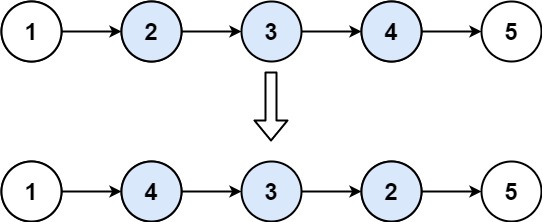Given the head of a singly linked list and two integers left and right where left <= right, reverse the nodes of the list from position left to position right, and return the reversed list.
Example 1:

Input: head = [1,2,3,4,5], left = 2, right = 4 Output: [1,4,3,2,5]
Example 2:Input: head = [5], left = 1, right = 1 Output: [5]
Constraints:
- The number of nodes in the list is
n. 1 <= n <= 500-500 <= Node.val <= 5001 <= left <= right <= n
Follow up: Could you do it in one pass?
My solution is finding the reversed head and tail node and keep the node index in hash map, then iterate through and relink the nodes.
# Definition for singly-linked list.
# class ListNode:
# def __init__(self, val=0, next=None):
# self.val = val
# self.next = next
class Solution:
def reverseBetween(self, head: Optional[ListNode], left: int, right: int) -> Optional[ListNode]:
if left == right:
return head
node_map = {}
curr = head
index = 1
while index <= right:
node_map[index] = curr
curr = curr.next
index += 1
if left != 1:
reverse_head = node_map[left - 1]
else:
reverse_head = node_map.get(index - 1)
right -= 1
head = reverse_head
for i in range(right, left-1, -1):
reverse_head.next = node_map[i]
reverse_head = reverse_head.next
reverse_head.next = curr
return head

搶先發佈留言